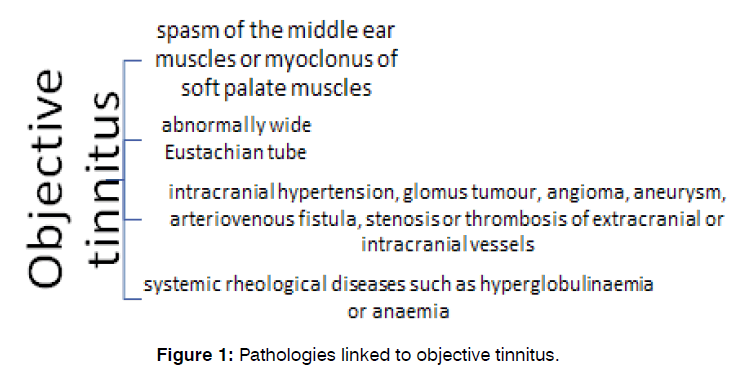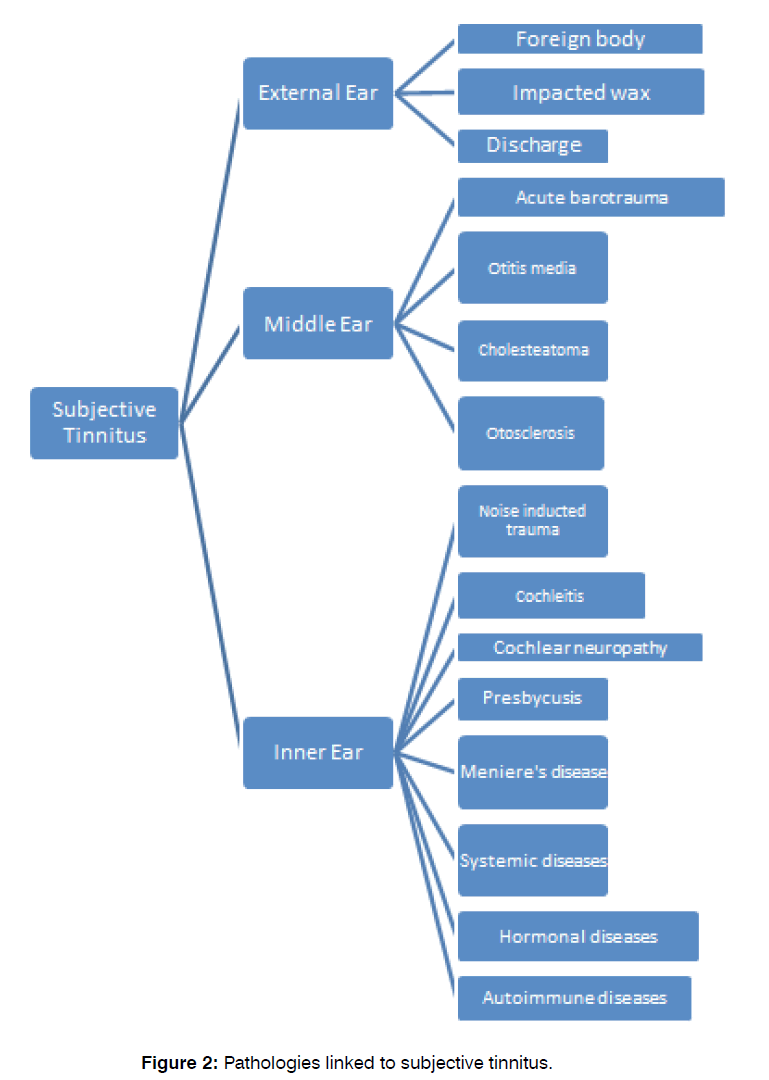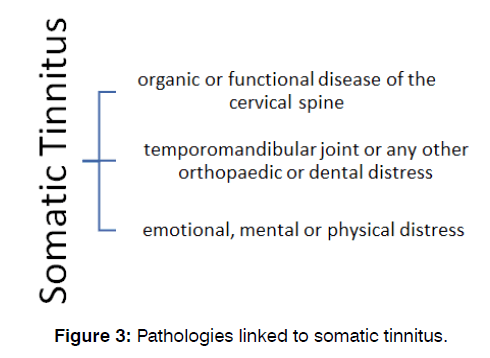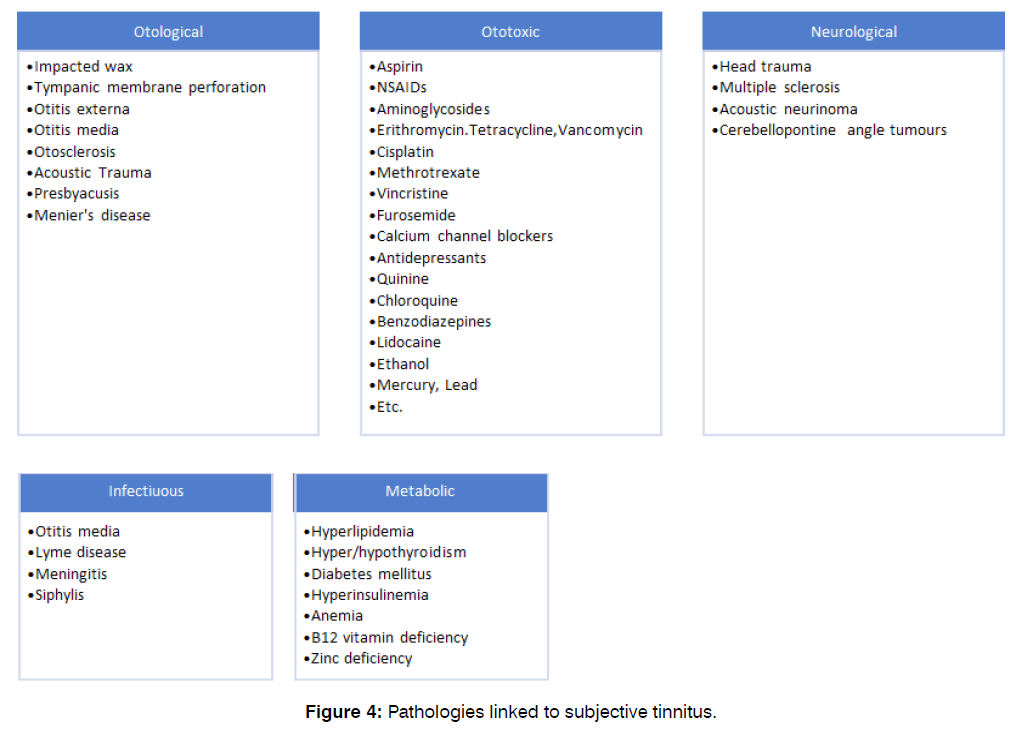The International Tinnitus Journal
Official Journal of the Neurootological and Equilibriometric Society
Official Journal of the Brazil Federal District Otorhinolaryngologist Society
ISSN: 0946-5448

Google scholar citation report
Citations : 12717
The International Tinnitus Journal received 12717 citations as per google scholar report
The International Tinnitus Journal peer review process verified at publons
Indexed In
- Excerpta Medica
- Scimago
- SCOPUS
- Publons
- EMBASE
- Google Scholar
- Euro Pub
- CAS Source Index (CASSI)
- Index Medicus
- Medline
- PubMed
- UGC
- EBSCO
Volume 27, Issue 1 / June 2023
Research Article Pages:47-53
10.5935/0946-5448.20230008
Diagnostic Value of Different Types of Tinnitus
Authors: Laura Vasilescu, Arthur-Emanuel Weisman
PDF
Abstract
Introduction: Tinnitus is the perception of sound when no external objective noise is present. It is not defined as an illness, but rather a symptom of an underlying process. Although it is a widely prevalent and distressing otologic issue, its pathological mechanism is not entirely known.
Aim: The present paper aims to discover if tinnitus characteristics can guide us in the diagnosis of the pathology that produces it.
Methods: This paper uses literature review approach from various publications, including PubMed and The International Tinnitus Journal which include discussed elements related to classification of tinnitus, characteristics of tinnitus, aetiology of different types of tinnitus, and patient’s description of tinnitus. The study was conducted between December 2021 and June 2022 and included publications dated from 1992 until 2022. The focus was on the characteristics of tinnitus and their capability to guide the diagnosis process.
Results: 30 publications were found suitable for this research and described the proper characteristics of tinnitus and their significance in the diagnosis process.
Conclusion: The characteristics of tinnitus do not have the ability to firmly diagnose the pathology which determines tinnitus, yet it may guide the diagnosis.
Keywords: Characteristics of tinnitus, Objective tinnitus, Subjective tinnitus, Diagnosis
Introduction
Tinnitus is the perception of sound when no external objective noise is present. It is not defined as an illness, but rather a symptom of an underlying process. Although it is a widely prevalent and distressing otologic issue, its pathological mechanism is not entirely known.
Tinnitus is described in literature as a symptomatic perturbation at any level of the elements forming the auditory pathway and including the auditory cortex [1]. Furthermore, some researchers concluded that noise perceived by patients in the ear or head that persists for at least 5 minutes, with twice a week interval defines tinnitus [1].
Epidemiologic studies illustrate that the prevalence of tinnitus in the USA is 8% to 25.3% of the population [2] while in Europe it represents 14.7% of the population (14% in men and 15.2% in women). In addition, the prevalence and severity of this symptom increase with age [3].
Materials and Methods
The present paper aims to discover if tinnitus characteristics can guide us in the diagnosis of the pathology that produces it. This paper is done using a qualitative study design with the literature study approach covering literature seeking, identifying, analyzing, and useful interpreting previous studies that discussed elements related to classification of tinnitus, characteristics of tinnitus, aetiology of different types of tinnitus, and patient’s description of tinnitus. Literature searching was done from December 2021 until June 2022 and the strategy used was online and manual search of suitable articles. The International Tinnitus Journal and PubMed were the major sources to collect literature in the full-text original article manner published between 1992 and 2022. In addition, reports from other sources, such as European Manual of Medicine, Otorhinolaryngology, Head Neck Surgery volume, Taylor’s Manual of differential diagnosis and various expert online or magazine publications from Romania that have relevant topics, were also used in this study.
Some keywords taken into account for the searching process: Objective and subjective and tinnitus; disease and tinnitus characteristics or tinnitus description. The inclusion criteria are literatures (1) in English or Romanian; (2) published between January 1992 until June 2022; (3) full text original article; (4) literature review and experiments, inclusive of human studies; (5) discussions about types of tinnitus, patient’s perception of tinnitus, manifestation of tinnitus. Literature research that exceeded the limit of time, were in other languages, had forbidden access to the full-text paper, had little to no details about the implication of diseases in the development of tinnitus or were excluded.
Result
In order to describe tinnitus, it is useful to differentiate between objective and subjective tinnitus. Objective tinnitus incorporates an existent endogenous acoustic source such as a pathological middle ear, Eustachian tube, soft palate or extra cranial or intracranial vessels. This sound may also be heard using a stethoscope, but those cases are rather scarce [4]. (Figure 1) contains commonly encountered pathologies linked to this type of tinnitus. Contrary to the aforementioned type, the subjective type can only be heard by the affected patient and is due probably to deficient neuronal plasticity in the central auditory system. Thus, subjective tinnitus may be considered a symptom of any pathology affecting elements of the peripheral and/or central auditory system which leads to disturbance of hearing. (Figure 2) contains commonly encountered pathologies linked to this type of tinnitus. Somatic tinnitus is described in literature as a subtype of subjective tinnitus [5, 6]. Which derives from somatic disorders of the musculoskeletal system? This type of tinnitus may be influenced by the patient’s movement of the head, neck, eyes or upper torso [7-10]. (Figure 3) contains commonly encountered pathologies linked to this type of tinnitus.
General Characteristics: When differentiating between the types of tinnitus, talking to the patient represents the first step to orienting the diagnosis and building the plan of management. There are several key questions which firmly contour the type of tinnitus, its behavior and severity. The characteristics of tinnitus can be divided into several main categories as shown in (Table 1).
| Characteristics of Tinnitus Revealed by Anamnesis | ||
| Localisation | Unilateral/Bilateral | |
| Duration | Intermittent/Continuous | |
| Onset | Acute/Chronic | |
| Frequency | Episodes per day/week/month/year | |
| Accompanying symptoms | Hypoacusis, hyperacusis or phonophobia, vestibular complaints | |
| Intensity | Masking level by environmental noise(grade I-III)* | |
| Pattern | Fluctuant or constant loudness | |
| Visual analogue scale (range from 1 to 10) | Loudness and Annoyance | |
| Trigger | Existence of any kind of trigger(physical, mechanical, chemical component/ exposure to any kind of noise) | |
| Alleviating/amplifying circumstances | Body position, body movement | |
| Personal physiological/pathological history | Otorhinolaryngological diseases and surgery | |
| Head trauma and/or other accidents | ||
| Internal, neurological, psychiatric or psychosomatic or orthopaedic diseases | ||
| Other complaints (sleep disturbance, concentration and attention problems, psychoemotional and psychosocial problems, etc.) | ||
| Habitual and working environment | Family status-Profession | |
| Recreational activities | Live music, earplugs, contact sports, activities that require the usage of different types of guns/explosives/fireworks, excessive usage of alcohol, tobacco, drugs, etc. | |
Table 1:Characteristics of tinnitus revealed by anamnesis.
Nevertheless, when describing the type of noise perceived, patients tend to compare the sound with various external sounds such as nature, industrial, household, pulsating or musical sounds. Depending on this comparison, the described sound can be categorised into one of the aforementioned types of tinnitus and may, furthermore, guide the physician into finding a possible source of tinnitus.
Objective Tinnitus Characteristics: Concerning the pathologies that are linked to objective tinnitus, they can be divided into 3 main categories: Vascular disease, neurological disease and Eustachian tube dysfunction [11, 12]. (Table 2) illustrates common sound comparisons and their link to the aforementioned pathologies. Pulsatile tinnitus is used to describe a rhythmical sound which may be heard when there is a modification of the blood flow in the vessels near the ears correlating with the heartbeat [13]. This modification might be due to generalized increased blood flow, in pathologies such as severe anaemia, hyperthyroidism or thyrotoxicosis or in physiological conditions such as pregnancy or effortdemanding exercises. Local increased blood flow may be due to tumours occurring in the head and neck region which develop their own blood supplies. Remanent vessels after birth such as stapedial artery are noted in literature as a possible cause of pulsatile tinnitus. Surgically removing the remanent stapedial artery leads to disappearance of the pulsatile tinnitus [14-16]. The development of atheromatous plaques or atherosclerosis in arteries of the head and neck leads to turbulent blood flow, which is, nonetheless, a possible cause of pulsatile tinnitus. As illustrated in (Table 2) there are several pathologies which produce pulsatile tinnitus, not in relation to the heartbeat and which might be continuous. This pulsating sound may be produced by muscles, such as tensor tympani or stapedius in myoclonus. A dysfunctional Eustachian tube correlates the pulsatile tinnitus to the rhythmicity of breathing. Not only may tinnitus be perceived in pathological conditions, but it also may be perceived in healthy individuals with intact tympanic membrane, who are stimulated to forcefully close their eyes or firmly clench their teeth. This happens due to the contraction of tensor tympani muscle. This means that the handle of the malleus is retracted making the tympanic membrane to be tensed. Nonetheless, imaging procedures like CT, MRA, and MRI help in contouring a clearer diagnosis and indicate the exact localisation of the possible underlying pathology.
| Common Sound Comparisons and their Link to Pathologies for Objective Tinnitus | |
| Intracranial/Systemic hypertension | Venous murmur, pulsating sound (heartbeat, swooshing or whooshing |
| Arteriovenous fistula (dural venous thrombosis) | Whistling, pulsating sound |
| Arterial murmurs associated with temporal bone | Turbulent, pulsating sound |
| Paragangliomas | Pulsating sound (growth of the tumour might lead to hearing loss) |
| Myoclonus (palatine muscles, stapedius muscle, tensor tympani muscle) | Rapid and intermittent click/punch sound |
| Dysfunctional eustachian tube | Ocean wave, click/crack/snap sound while breathing |
Table 2: Common sound comparisons and their link to pathologies for objective tinnitus.
Subjective Tinnitus Characteristics: When characterising tinnitus, it is useful to determine its localisation. Unilateral tinnitus on a clinical and imagistic (CT/MRI) normal ear, followed by vertigo and/or hearing loss indicates that there might be an otological pathology such as Meniere’s disease or acoustic neuroma meanwhile other neurological signs and symptoms might indicate that the cerebral, cerebellar and/or brainstem component is affected. Clinically and/or imagistic abnormal ear is a possible cause of unilateral tinnitus due to impacted wax or otitis externa/media. In addition, patients tend to complain of auricular fullness17. Bilateral tinnitus might be accompanied by hearing loss when the ear is affected by otosclerosis, presbycusis, and ototoxicity or is the sole symptom when there is metabolic, psychologic or ototoxicity influence. Furthermore, bilateral tinnitus might be due to head trauma [18-20]. Regarding the pathologies linked to subjective tinnitus, they have been divided into 5 categories that represent the source of the tinnitus, such as: Otological, ototoxic, neurological, infectious and metabolic as shown in (Figure 4). Contrary to the objective tinnitus, the subjective type appears to be influenced by various pathologies and is described in several ways. Patients may describe their tinnitus as similar to nature sounds, such as cicadas, crickets, winds, or household and/or industrial sounds including falling tap water, grinding steel, escaping steam, fluorescent lights or running engines. This stems from the fact that there is an abnormal neuronal activity at a subcortical level of the auditory pathway. In other words, the similarity of tinnitus with outside sounds is connected to the patterns stored in auditory memory. The limbic system mediates this connection [21].
Otological and Neurological Source of Tinnitus: Obstacles that intervene in the physiological sound transmission pathway (impacted wax, perforation of the tympanic membrane, otitis externa, otitis media, and otosclerosis) may cause conductive hearing loss and/or tinnitus. This is generally temporary, depending on the presence of the obstacle in the ear and may sound like high-pitched cicadas, crickets, winds or rings. Regarding acoustic trauma, presbyacusis, otosclerosis, etc., tinnitus is described as a constant high-pitched whistling. In contrast, Meniere’s disease presents with fluctuant tinnitus similar to a low-pitched buzzing. Moreover, the tonality of Meniere’s disease tinnitus is between 125 Hz to 250 Hz [22].
Ototoxic Source of Tinnitus: Various chemical substances may take part in the development of tinnitus. On one hand, this may be due to medication overdose. On the other hand, it might be due to an underlying pathology which determines high drug retention (for example: Liver or renal failure). In such cases, patients describe hypoacusis and difficulty in understanding speech. Tinnitus is similar to a high-pitched noise and may include sensation of ear blockage.
Metabolic Source of Tinnitus: Chronic pathologies are cited in literature as possible aetiology for tinnitus. Depending on the duration, severity and control of the disease, metabolic modifications may play a role in the development of this symptom. The characterisation of tinnitus is similar to the aforementioned sources [23]. In general, patients tend to locate their tinnitus at a pitch above 3 kHz [24, 25].
Somatic Tinnitus Characteristics: Although a subtype of subjective tinnitus, somatic tinnitus differentiates itself through the mechanism of appearance. It may appear in organic or functional disease of the cervical spine, temporomandibular joint or any other orthopaedic or dental distress, emotional, mental or physical distress. Cervical spine can be affected in different parts.
Patients who develop pathology at the craniocervical junction tend to develop tinnitus which resembles a unilateral or bilateral high-pitched whistle. Those who present with lower cervical spine changes scarcely complain of tinnitus. Modifications in C2-C3 or C3- C4 regions are to be considered notable for tinnitus manifested as splashing or crackling noises [26].
Disorders of the temporomandibular joint frequently lead to tinnitus due to muscle contractions, clenching of jaw or bruxism. Tinnitus manifests itself as the sound of clicking and popping [27]. In bruxism, the intensity of tinnitus is louder upon awakening, while it may disappear during sleep but return within a few hours during muscle contractions or clenching of jaw. Although it depends on the mood of the patient, tinnitus may be unnoticed or less disturbing or it may affect the patient’s quality of life [28].
It may be present in emotional, mental or physical distress and it usually assembles musical tunes or voices without understandable speech and at the same time may also have similar characteristics as those described for subjective tinnitus. This type of tinnitus is considered to be a central type because it implies that there is reverberatory activity within neural loops leading to difficulty in processing the information in the auditory cortex.
Discussion
There are several theories that are considered to be involved in the development process of tinnitus. Acknowledging those theories and correlating them with the manifestation of tinnitus may be an important step into accurately discovering the cause of this hearing disturbance. It is crucial to differentiate between the peripheric auditory system and the central auditory pathway as detecting the component/s affected in one of them may ease the path to an aimed diagnosis.
Edge or Contrast Theory: The organ of corti has outer hair cells, which can be partially damaged by ototoxic drugs or extreme noise. This leads to an increase in the spontaneous activity and, thus, to changes in the peripheral auditory pathway.
Discordant Theory: The inner hair cells seem to be the source of tinnitus. Inner hair cells are more resistant to ototoxic drugs and noise-induced trauma compared to outer hair cells.
Dorsal Cochlear Nucleus: Exposing the dorsal cochlear nucleus to extreme noise and chemotherapeutic drugs has a role in damaging the outer hair cells of the cochlea, therefore, generating tinnitus.
Crosstalk Theory: This theory includes patients with acoustic neuroma (vestibular schwannoma). If the auditory nerve fibres are intact and other cranial nerves are affected, artificial synapses may grow between individual auditory nerve an fibre, which leads to phaselocking of the spontaneous activity of groups of auditory neurons.
Auditory Neural Plasticity Theory: Cochlear damage stimulates neural activity in the auditory pathway [29]. When any component of the cochlea is affected, aberrant pathways which try to adopt the affected part’s roles emerge, leading to the generation of tinnitus [30]. Every described theory treats particular aspects of the generation of tinnitus. Correlating them with the clinical and imagistic results may explain the behaviour of tinnitus, as well as may indicate its aetiology. The different characterisations of the disturbant sound create a narrative for diagnosis.
Conclusion
Until now, literature has given little importance to the sound type of tinnitus. The characteristics of tinnitus do not have the ability to firmly diagnose the pathology which determines tinnitus, yet it may guide the diagnosis. Nevertheless, besides clinical aspects, the complete diagnosis of any pathology still needs complementary aid from CT, MRI, MRA, etc. When discussing tumours, the gold standard of diagnosis remains the histopathology analysis, even if the description of tinnitus given by the patients might slightly help, meaning that it could give a hint about the underlying disease.
References
- Kamlesh Dubey. Tinnitus: Summary of current understanding of the pathophysiology mechanisms in different ear diseases. Int Tinnit J. 2022;26(1):63-7.
- Bhatt JM, Lin HW, Bhattacharyya N. Prevalence, severity, exposures, and treatment patterns of tinnitus in the United States. JAMA Otolaryngol Head Neck Surg. 2016;142(10):959-65.
- Biswas R, Lugo A, Akeroyd MA, Schlee W, Gallus S, Hall DA. Tinnitus prevalence in Europe: A multi-country cross-sectional population study. Lancet Reg Health Eur. 2022;12:100250.
- Anniko M, Bernal-Sprekelsen M, Bonkowsky V, Bradley PJ, Iurato S. Otorhinolaryngology, head and neck surgery. Springer. 2010 22.
- Han BI, Lee HW, Kim TY, Lim JS, Shin KS. Tinnitus: Characteristics, causes, mechanisms, and treatments. J Clin Neurol. 2009;5(1):11-9.
- Bolos A, Cozma S, Szalontay AS. Particularities of tinnitus in children and adolescents. Medical Media. 2016.
- Dauman R, Tyler RS. Some considerations on the classification of tinnitus. Tinnitus. 1992;91:225-9.
- Ralli M, Salvi RJ, Greco A, Turchetta R, de Virgilio A, Altissimi G, et al. Characteristics of somatic tinnitus patients with and without hyperacusis. PLoS One. 2017;12(11):e0188255.
- Shore SE, Roberts LE, Langguth B. Maladaptive plasticity in tinnitus triggers, mechanisms and treatment. Nat Rev Neurol. 2016;12(3):150-60.
- Wright EF, Bifano SL. The Relationship between Tinnitus and Temporomandibular Disorder (TMD) Therapy. Int Tinnitus J. 1997;3(1):55-61.
- Dalrymple SN, Lewis SH, Philman S. Tinnitus: Diagnosis and management. Am Fam Phys. 2021;103(11):663-71.
- Paulman PM, Paulman AA, Harrison JD, NAsitr LS, Jarzynka KJ. Taylor: Manual de diagnostic diferential. 3rd ed., Wolters Kluwer. 2014.
- Amans M, Glastonbury C, Smith W, Saloner D, Limb C, Narsinh K, et al. Pulsatile tinnitus causes and treatments. University of California, 2020.
- McFerran D. Pulsatile tinnitus. Norfolk and Norwich Univ Hospital Foundation Trust, England. 2022.
- Rock EH. Objective tinnitus and the tensor tympani muscle. Int Tinni J. 1995;1(1):30-37.
- Murphy MP, Seidman MD, Baugh RF. Can a persistent stapedial artery be safely and effectively removed? A case report with therapeutic implications. Int Tinnitus J. 1995;1(2):147-52.
- Weber PC, Klein AJ. Hearing loss. Med Clin North Am. 1999;83:125-37.
- Crummer RW, Hassan GAA. Diagnostic approach to tinnitus. Am Fam Phys. 2004;69:120-126.
- Claussen CF. Chemically induced or drug induced tinnitus. Int Tinnitus J. 1996;12:21-2.
- Nicolas-Puel C, Faulconbridge RL, Guitton M, Puel JL, Mondain M, Uziel A. Characteristics of tinnitus and etiology of associated hearing loss: a study of 123 patients. Int Tinnitus J. 2002;8(1):37-44.
- Jastreboff PJ, Hazell JW. A neurophysiological approach to tinnitus: Clinical implications. Br J Audiol. 1993;27(1):7-17.
- Douek E, Reid J. The diagnostic value of tinnitus pitch. J Laryngol Otol. 1968;82(11):1039-42.
- Kazmierczak H, Doroszewska G. Metabolic disorders in vertigo, tinnitus, and hearing loss. Int Tinnitus J. 2001;7(1):54-8.
- Berrios GE. Musical hallucinations: A statistical analysis of 46 cases. Psychopathology. 1991;24(6):356-60.
- Baguley DM, Williamson CA, Moffat DA. Treating tinnitus in patients with otologic conditions. Tinnitus treatment. New York: Thieme. 2006:41-50.
- Montazem A. Secondary tinnitus as a symptom of instability of the upper cervical spine: Operative management. Int Tinnit J. 2000;6:130-133.
- Upton LG, Wijeyesakere SJ. The incidence of tinnitus in people with disorders of the temporomandibular joint. Int Tinnitus J. 2004;10(2):174-6.
- Dobie RA. Tinnitus and depression. Int Tinnitus J. 1997;3:33-4.
- Salvi RJ, Wang J, Ding D. Auditory plasticity and hyperactivity following cochlear damage. Hear Res. 2000;147:261-74.
- Lockwood AH, Salvi RJ, Burkard RF, Galantowicz PJ, Coad ML, Wack DS, et al. Neuroanatomy of tinnitus. Scand Audiol Suppl. 1999;51:47-52.
1Department of ENT, Central Military Emergency University Hospital, Bucharest, Romania
2ENT Consultant, Department of Romania-Audiology, Institute of Phono-Audiology and ENT Functional Surgery, Bucharest, Romania
Send correspondence to:
Laura Vasilescu
Department of ENT, Central Military Emergency University Hospital, Bucharest, Romania. Email: dr.lauravasilescu@gmail.com
Tel No: +40 726 678 947.
Paper submitted on August 19, 2022; and Accepted on April 20, 2023
Citation: Vasilescu L, Weisman AE. Diagnostic Value of Different Types of Tinnitus. Int Tinnitus J. 2023;27(1):47-53.






